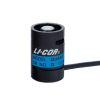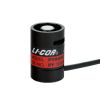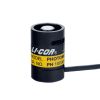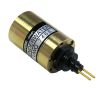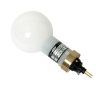LI-COR LI-1500 Light Sensor Logger
Features
- Weather resistant console constructed to withstand impact
- Sample and log measurements up to 500 Hz
- Optional GPS for recording location of measurements
- Free ground shipping
- Expedited repair and warranty service
- Lifetime technical support
- More
Overview
The LI-COR LI-1500 is a light sensor logger with a menu-driven interface, making it easy to use. Attach LI‑COR light sensor(s) to the three BNC connectors. Log manually or use menus to set up one-time, daily, or continual measurement routines. Sampling rates and logging intervals are user-selectable.
Durable
The LI‑1500 features rugged housing and a compact design suitable for handheld outdoor use. A rubber seal between the two halves also serves as a shock cushion. The LI‑1500 is powered by four AA batteries providing over 80 hours of operation with typical usage or 40 hours with the GPS option turned on. Power can also be supplied from an AC wall outlet with the provided USB adapter.
Data Presentation
Graph large data sets using LI‑COR’s FV7x00 software, available for free download. Also, view real-time light measurements, GPS data, and other variables on the eight-line display screen.
Data Storage
The LI‑1500 stores a large amount of logged data on an internal SD card (1 GB of flash memory). Store up to 100 sensor configurations and sensor-specific calibration coefficient information for later use. Download the sensor’s calibration certificate from the LI‑COR website. Enter the calibration coefficient (multiplier) and the date of the last calibration just once. When attached to a computer, the LI‑1500 acts as a mass-storage device with a simple drag-and-drop file system. Logged data can be transferred to a computer with the included USB cable. Data is formatted for easy import. Configurations and sensor calibration data can also be transferred to a computer and then shared with other LI‑1500 units
Connections
Use the LI‑1500 with LI‑COR sensors to log photosynthetically active radiation (PAR), global solar radiation, and light (the visible spectrum). PAR can also be measured along transects under a plant canopy with the LI-1500. Connect up to three sensors at the same time. For instance, use two PAR sensors to measure incident radiation above and below a plant canopy. Features a built-in math function for measuring vertical attenuation using two underwater PAR sensors. The three input ports also allow for the measurement of incident PAR above water while measuring simultaneous upwelling and downwelling PAR below water.
Global Positioning System (GPS)
The LI‑1500 features an optional global positioning system (GPS) for recording the location of measurements. The GPS facilitates repeated visits to the same location for tracking light levels over time. GPS data can be logged independently or with light data.
- (1) LI-1500 light sensor logger
- (4) AA batteries
- (1) USB cable
- (1) AC to DC power supply adapter
- (1) Carabiner clip
- (1) Carrying case
- (1) Instruction manual
In The News
Wildfire Prevention in the Sierra Nevada Region with the Yuba Watershed Institute
Though recent wildfires have sparked new conversations about wildfire management and response, groups like the Yuba Watershed Institute have been monitoring the forests and water resources of the Sierra Nevada region for decades, managing approximately 5,000 acres of land with the Bureau of Land Management (BLM) and about 7,000 acres in private land partnerships. The goal of the Institute is to work with local communities and land agencies to improve watershed and forestry management through informed practices and public outreach. The goals of the Yuba Watershed Institute are three-fold: Improve the ability of fire suppression agencies like the California Department of Forestry and Fire Protection ( CAL FIRE ) and the US Forest Service.
Read MoreWave Sensors Integration with NexSens Buoys: A Cutting-Edge Solution for Wave Measurment
Real-time wave data supports accurate weather prediction, safe and efficient maritime operations, and provides valuable safety and operating condition information for recreation and commercial fishing. Understanding wave dynamics also helps with the design of protective coastal structures like seawalls, breakwaters, and jetties. It also supports better prediction of their impact on sediment transport and coastal geomorphology. Wave data is a key factor in qualifying and designing offshore wind farms and harnessing kinetic energy for electrical generation. It helps with the understanding of ocean-atmosphere interactions and contributes to studies of sea-level rise and climate change impacts.
Read MoreSpring 2025 Environmental Monitor Available Now
In the Spring 2025 edition of the Environmental Monitor, we highlight partnerships across the world and the importance of collaboration between government agencies, universities, environmental groups, local communities, and other stakeholders. From great white shark research in Cape Cod to monitoring fisheries in Lake Erie, this latest edition underscores partnerships that connect stakeholders in a watershed through environmental data. With an emphasis on data sharing, a combination of real-time and discrete sampling keeps the public and partners informed of environmental conditions. Our writers also sought out science professionals dedicated to working with peers within and outside of the environmental sector.
Read More





























